
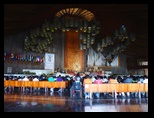
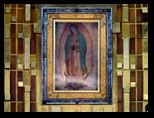
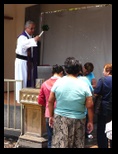
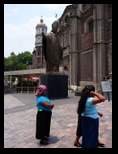
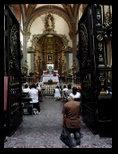
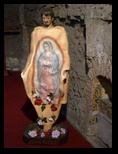
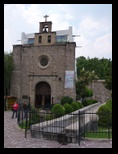
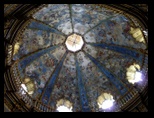
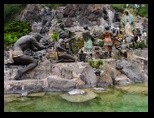


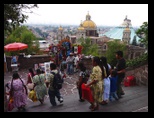

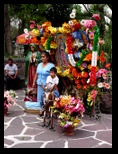
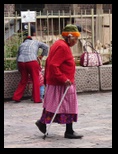
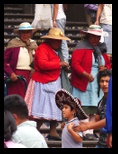

Click on a photo to enlarge it.
Today we took the metro all the way to the northern part of Mexico City to visit the famous Basílica de Guadalupe. Our Lady of Guadalupe is a celebrated
Catholic image of the Virgin Mary also known as the Virgin of Guadalupe. According to the traditional account, the image appeared
miraculously on the cloak of Juan Diego, a simple indigenous peasant, on the hill of Tepeyac near Mexico City in December 1531.
According to the traditional accounts of the Guadalupan apparitions, during a walk from his home village to Mexico City early on the morning of December 9, 1531,
Juan Diego saw a vision of a young girl of fifteen to sixteen, surrounded by light. Speaking in the local
language of Nahuatl, the Lady asked for a church to be built at that site in her honour. From her words, Juan Diego recognized her as the Virgin Mary. When he told
his story to the Spanish bishop, Fray Juan de Zumárraga, the bishop asked him to return and ask the lady for a miraculous sign to prove her claim. The Virgin then
asked Juan Diego to gather some flowers from the top of Tepeyac Hill, even though it was winter when no flowers bloomed. There, he found Castilian roses (which were
of the Bishop's native home, but not indigenous to Tepeyac). He gathered them, and the Virgin herself re-arranged them in his tilma, or peasant cloak. When Juan Diego
presented the roses to Zumárraga, the image of the Virgin of Guadalupe miraculously appeared imprinted on the cloth of Diego's tilma.
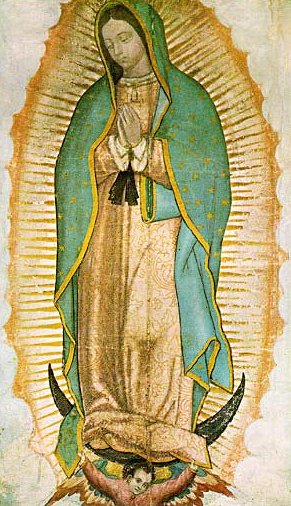
The miraculous image, which is preserved in the Basilica of Our Lady of Guadalupe, shows a woman with native features and dress. She is supported by an angel whose
wings are reminiscent of one of the major gods of the traditional religion of that area. The moon is beneath her feet and her blue mantle is covered with gold stars.
The black girdle about her waist signifies that she is pregnant. Thus, the image graphically depicts the fact that Christ is to be "born" again among the peoples of
the New World, and is a message as relevant to the "New World" today as it was during the lifetime of Juan Diego.
Some historians believe the icon represents both Virgin Mary and the indigenous Mexican goddess Tonantzin. Others believe the Virgin was a simplified and sanitized
version of Coatlicue, the Aztec mother goddess. This syncretism may have provided a way for 16th century Spaniards to gain converts among the indigenous population of
early Mexico; it may also have provided a method for 16th century indigenous Mexicans to covertly practice their native religion.
Officially known as the "Templo Expiatorio a Cristo Rey," the construction of the old basilica began in 1531 and was not finished until 1709. It is characterized by
its doric interior and marble statues of Juan Diego and Fray Juan de Zumárraga. The church was granted basilica status by Pope Pius X in 1904.
The apron of Juan Diego was housed in this church from 1709 to 1974. In 1921 a bomb planted in a flower vase near the altar by a anticlerical activist exploded
causing great damage to the interior of the building. The apron survived the incident largely undamaged.
The old basilica was sinking as a result of the weakness of the ground, as the city was built on a former lake. As a consequence a new, more spacious, basilica
was built. The old one was closed for many years and repairs have recently finished. It is now again open to the public and thousands visit to worship.
It is a very important place for Mexico City.
The modern basilica was built between 1974 and 1976 by the Mexican architect Pedro Ramírez Vázquez who was also the architect of the Estadio Azteca (Spanish for
"Aztec Stadium"). It is a circular building constructed in such a way as to allow maximum visibility for the image to those inside. The structure is supported by
350 pylons that prevent the basilica from sinking with the rest of the ground.
The Basilica is considered as the second most important sanctuary of Catholicism, based on the number of pilgrims per year, after the Vatican
City. It has sitting space for 10,000 people inside the premises. However, temporary seats are often placed in the atrium that allow up to 40,000 people to
take part of the Mass and other ritual celebrations. There are nine chapels in the ground level each able to seat about 200 people.
There was a big service in the new Basilica and we were not able to get close to the famous cloak. This is the only church in the world that has a conveyor belt to avoid
jams in front of the cloak.
We were not too impressed by the new Basilica - quite ugly. There are other chapels on the grounds. All of them surrounded by beautiful gardens. We walked all the way up to the
Capilla del Cerrito on top of the hill. On a clear day you get a fabulous look onto Mexico City.
Kirsten went on her own pilgrimage. She lost a leg of her small tripod and didn´t notice for a while. Hence we were halfway around the grounds and Kirsten had to backtrack to find the
leg. Was it the blessing of Guadalupe or pure coincidence ... who knows? Kirsten found the leg!
We were tired and took the metro back home around 4pm. The metro is one of the busiest in the world transporting approximately 4.5 million people every day,
surpassed only by subway lines in Moscow (7.5 million), Tokyo (5.9 million), and New York City (5.1 million). It is heavily subsidized, and has the lowest fares
in the world, each trip costing 3.00Mex$ and taking each passenger to almost any place in this enormous city from 05:00 am to midnight. Several stations display
pre-Columbian artifacts and architecture that were discovered during the metro's construction. The first portions of the 207 km metro system, which is the largest
in Latin America, were opened in 1969 and it has expanded to 11 lines with 175 stations.
Vendors are selling CDs, cosmetics, food, toys and other things for 5-10 pesos. We bought a few toys for Kirsten´s nephews and nieces. Many vendors are handicapped and
very poor.
Riding the metro